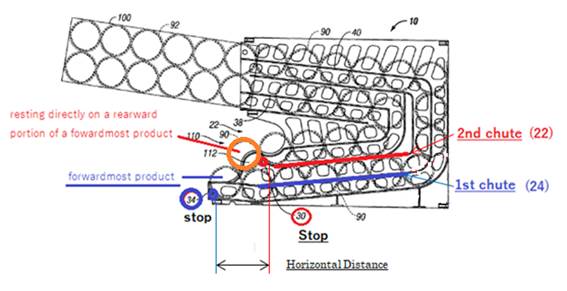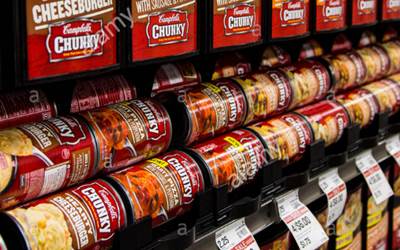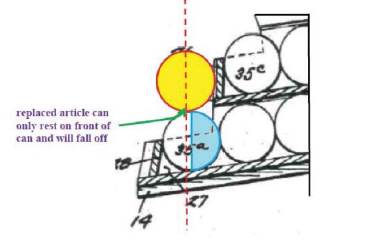
|
CAFC判決
Campbell
Soup v. Gamon Plus 2019年
10月15
日 Obviousnessに関して
OPINION
by Chief JUDGE Prost (Newman and Moore) Summarized
by Tatsuo YABE 2019-11-10
|
|
本事案はクレームの自明性に関するもので、久々に全くもって機械(メカ)の発明に関するCAFC判決である。問題となった特許発明はスープなどのシリンダー状の製品を陳列し取り出しを容易にしたラック(スーパーなどに設置するラック)に関し、購買者が製品をピックアップした後に気が変わりラックに戻すときに最前列の製品の上に容易に載置する(戻す)ことができるという構造に関する。そのような構造はスープ缶で有名なキャンベルのラックに採用されている。
|
キャンベルは問題となる特許クレーム(USP
No. 8,827,111)のクレームを無効にするべくPTABにIPRを申請し、PTABはIPR手続きを開始する要件(there
is a reasonable likelihood that at least one of the claims challenged in the
petition is unpatentable: 37 CFR 42.108)を満たしていると判断しIPRが開始されたが審理の途中で問題となる特許クレームは非自明であると判断した。その後のCAFCでの審理においてもPTABの判断(審決)は支持された。
|
久々に見る自明性判断に対する分かりやすい判例である。一見に値すると思います。(以上筆者)
|
■■■■■■■■■■■■■■■■■■■■■■■■■■■■■■■■■■
■ 事件の背景:
CampbellはGamon社のUS
Patent No. 8,827,111に対してIPR手続きを申請し、特に争点となったのは当該特許のクレーム27をWeichselbaum(USP2382191)とNesso(EP
Publication No. 0490693)によって自明であると主張し、PTAB(特許庁審判部)にてIPR手続きが開始された。しかしPTABはIPRを開始する時点での判断を覆し当該クレーム27の自明性を否定した。同審決を不服としCampbellはCAFCに控訴した。
|
■ 特許権者:Gamon
■ 関連特許:USP
8,827,111(以下111特許)
■ IPR申請人:Campbell
■ 特許発明の概要:
111特許において、争点となった独立クレームはクレーム27のみで円柱状の製品(スープの缶など)を表示収納し取り出せるラックに関し、11にも及ぶ特徴(アイテム)が列記されているが特に問題となったのはアイテム9で以下の通り:
[アイテム9]
wherein the horizontal distance
that the stop structure (30) of the second chute
(22) is offset rearwardly from the stop structure
(34) of the first chute (24) is sufficient that one of the products
removed by a user from the rack can be replaced on the rack and supported by
resting directly on a rearward portion of a forwardmost product
(90) in the first chute (24);

|
即ち、上記図で示すように、第2シュート22のストッパー30の位置と第1シュート24のストッパー34の位置関係によって製品90を取り出したものの気が変わって購入を辞めたときに再度製品90(オレンジ色)を第1シュート24の最も前に位置する製品90の上(且つ後方)に戻すことができることを特徴とする。以下の写真で示すようにスーパーマーケットにあるCampbellのラックは当該アイテム9の特徴を満たしているようである(筆者)。
|
Campbellの製品陳列取出し用ラック(スーパーマーケット)

|
■ 争点:
111特許のクレーム27はWeichselbaum特許とNesso公開公報によって自明ではないとした審決は妥当か?
■ PTABの判断(自明性判断に最も関連する部分のみ):
Campbellは111特許のクレーム27はWeichselbaum特許とNesso公開公報によって自明であると主張した。主張の骨子はWeichselbaum特許の明細書2ページ右欄(コラム4)29〜32行目の記載、「当該発明装置は製品の様々なサイズにも適用できるように各種材料或いは所望されるサイズで製造可能である」という記載を根拠に下図右に示すように装置のサイズを変更せずに製品のサイズを小さくすると111特許クレーム27のアイテム9の特徴を満たすと主張した。(Nesso引例との組み合わせはクレーム27のアイテム9とは直接関係ない:筆者)
以下Weichselbaum特許の図3(左)とCampbellの主張する図3のModification(右)
|

PTAB(審判部)はCampbellの上記主張は説得性がないと判断した。即ち、Weichselbaum特許の当該記載箇所の意味合いを当業者は装置のサイズをそのままで製品のサイズを小さくするとは理解しない。最も妥当な解釈は製品のサイズに合わせてシュートのサイズ(装置のサイズ)を変更すると理解する。
■ CAFCの判断:
PTAB(審判部)の判断を全面的に支持した。
PTAB(審判部)は以下の説明図を付してWeichselbaum特許の開示を変更しない場合には以下のように取り出した製品を第1シュートの最前方の製品の上に戻すと前方に落ちると説明した。
PTABによるWeichselbaum特許図3の説明図
|

|
尚、Weichselbaum特許のコラム4(2ページ右欄)29-32行目の開示に対しても審判部の判断を支持した(以下原文の要部のみ)。
The
Board explained that “the most reasonable interpretation of
Weichselbaum is that one would modify the device size in proportion to changes
in the can size.” Id. at 42. In other words, reducing or increasing the
size of the can would result in proportionally reducing or increasing the size
of the device. The Board therefore concluded that “just as Weichselbaum,
in its unmodified form fails to teach limitation [9] of claim 27, a
proportionally scaled down version of Weichselbaum (display and cans) would
similarly fail to teach limitation [9].” Id.
For
example, Weichselbaum itself states that “[o]bviously, the device may be
made of any desired type of material or in any desired size to accommodate
varying sizes of cans to facilitate the dispensing thereof.” Weichselbaum
at col. 4 ll. 29–32. This teaching of Weichselbaum is
“‘such relevant evidence as a reasonable mind might accept as adequate to
support’” the Board’s conclusion that one of ordinary skill in the art
following Weichselbaum would use a proportionally smaller display when using a
smaller can.
The
Board is free to change its view of the merits after further development of the
record, and should do so if convinced its initial inclinations were wrong.” Trivascular,
Inc. v. Samuels, 812 F.3d 1056, 1068 (Fed. Cir. 2016).
審決を認容する。
|